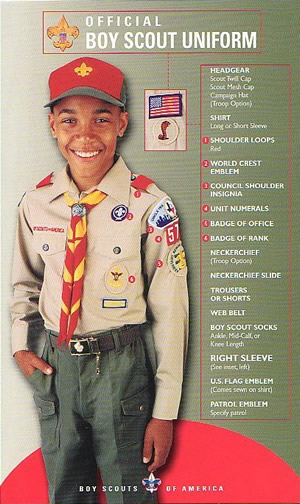|
Boy Scout Uniform
Field Dress Uniforms (FDU) (Formally Class A) are worn by scouts at Meetings, to and from activities, Boards of Review, PLC meetings, and Courts of Honor. SPL and adult leaders must wear Class A at all times. Full FDU uniform are worn at all Eagle Boards of Review. All scouts must wear same hat uniformity. Special hats may be worn (uniformly) at special events such as all scouts wearing a Braves hat when going to a Braves game together, etc. Full Class A uniforms include official Boy Scout hat or no hat at all. An official Boy Scout hat may be required for events at the Scoutmaster's discretion. Boy Scout Uniform Inspection Sheet Field Duty Uniform (Formally known as Class A)Official short sleeve shirt
Official scout pants or shorts (optional) Official BSA tweed belt Boy Scout Handbook Field Activity Uniform (Formally Class B)Troop 1 Field Activity T-shirt Official scout pants or shorts (optional)
Early UniformThe first Scout uniform was an impractical copy of the US Army uniform of 1910, which disregarded the far more practical English uniform designed by Baden-Powell. The early BSA uniform had no neckerchief, and Scouts generally wore knickers with leggings and a button-down coat with metal insignia. Scouts and adults both wore their rank insignia on their hats (adults were allowed to earn merit badges and ranks right along with the Scouts). 1922-1981 Uniforms.In 1922, the BSA modernized its uniforms to the style we would recognize today. Coats and leggings were dropped, and neckerchiefs were added. Scouts could wear shorts and knee socks in the summer, knickers and knee socks in the winter (trousers replaced knickers in 1944). Until 1948, all Scouts wore campaign ("Smokey the Bear") hats. At that time, the field (overseas) cap (popularized by World War II soldiers) was added. Red berets and baseball-style caps joined the options in 1972. Also in 1972, the BSA changed almost every uniform insignia, making them multi-color, standardizing the shapes, and adding wording to explain what they signify. Brightly colored patches replaced the old black-on-red patrol medallions and the black-on-khaki merit badges. Current Uniform.In 1981, fashion designer Oscar de la Renta designed a more attractive Scout uniform (at no charge). The more stylish new uniform maintained a clear Scout identity in its appearance, but used more rugged material and added colored shoulder loops. The most striking change was the switch to a two-color uniform (something many other countries have long had). A tan shirt and dark khaki-green trousers replaced the old medium khaki-green shirt and trousers (which in turn had replaced a medium khaki-brown). In 1989, along with the other changes largely restoring the pre-1972 program, the BSA changed its rank and office insignia so that they more nearly matched the pre-1972 insignia, keeping the wording but replacing the multi-colored backgrounds with backgrounds matching the tan shirt color. In 1990, the BSA added an optional "activity" uniform in addition to the standard field uniform (like the leggings of the 1950s, the expensive activity uniform has not caught on, mainly because Scouts must still own a field uniform for more formal occasions). In the early 1990s, the BSA discontinued its unpopular knee socks, replacing them with shorter khaki socks with a red band at the top. In 1995, responding to complaints (mostly from adults embarrassed about their ugly legs, I suspect), the BSA brought back the knee socks as an option. Shoulder Loops.Today's Scouts and Scouters wear colored shoulder loops to indicate the branch of the Scouting family to which they belong. Cub Scout leaders (and Webelos Scouts who choose to wear the Boy Scout uniform) wear blue loops (other Cub Scouts and Tiger Cubs do not wear loops), Boy Scouts and their leaders wear red, Varsity Scouts and their leaders wear orange, Venturers and their leaders wear green, District and Council Scouters wear silver, and Regional and National Scouters wear gold. The Most Important Change.With all these many changes, you know what is easily the most important one in the uniform's 86-year history? It's permanent press! Until the mid 1960s, uniforms were wrinkle-prone cotton or itchy wool. Ironing might last an hour or so (sometimes minutes). Modern, cotton/polyester permanent-press materials are a big improvement. Varsity/Venture Scout Uniforms.Varsity Scouts who belong to a Varsity team have the option of wearing the standard Boy Scout uniform with orange shoulder loops and Varsity Scout insignia, or they can wear a Varsity Scout T-shirt with non-uniform brown trousers. Venture Scouts, and Varsity Scouts in a troop, wear the standard Scout uniform with a "Venture" or "Varsity" strip above the "Boy Scouts of America" strip. |
Legal and Pseudo-Legal Stuff This site is entirely not-for-profit, and is provided as a service for members and parents of Boy Scout Troop 1. Any information obtained from this site, such as names, e-mail or postal addresses, may not be used for any commercial purposes, including business solicitations. We respect the privacy of our members. If you find information or photographs of yourself, and you'd like them removed, please contact us and such data will be removed immediately. We have also tried hard to verify the accuracy of the information presented on this site however, we are not responsible for any typographical or contextual errors that may exist. If you notice any such errors, please inform us and we'll correct them at our earliest convenience. |
